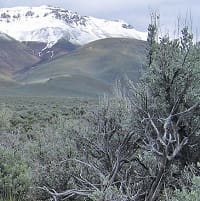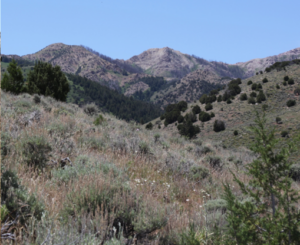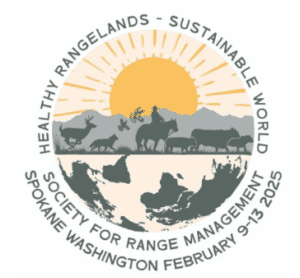Sagebrush
View article.
To help inform strategic and cost-effective investments, we conducted a quantitative assessment of wildfire risk for the sagebrush biome. We used a geospatial fire modeling approach, customized for the sagebrush biome, to estimate spatially explicit burn probability and expected average annual area burned within three Sagebrush Ecological Integrity classes under the Sagebrush Conservation Design: Core Sagebrush Areas (CSAs), Growth Opportunity Areas (GOAs), and Other Rangeland Areas. We further used indices of ecological resilience to disturbance and resistance to invasive grasses to characterize fire risk and recovery potential. Our approach indicates that nearly 530,000 ha are likely to burn in a typical contemporary fire year across the highest integrity Sagebrush Ecological Integrity classes (7% in CSAs and 31% in GOAs). Of the CSAs and GOAs likely to burn, nearly 9000 and 66000 ha, respectively, are expected to have low resilience or resistance and therefore highest loss potential. Cost-effective conservation investments should include wildfire protection for high-integrity sagebrush with low resilience or resistance. Protection objectives may be met with strategically placed fuel breaks intended to enhance fire prevention and containment efforts. Fuel treatments, including prescribed fire and mechanical activities outside of fuel breaks, are by contrast best suited for high-integrity areas with relatively high resilience and resistance. Those activities should be risk-informed and intended to maintain or improve ecological integrity and resilience to wildfire rather than to exclude fire altogether.
View article.
We found that within the sagebrush biome, fuel breaks are generally located in areas with high burn probability and are thus positioned well to intercept potential wildfires. However, fuel breaks are also frequently positioned in areas with lower predicted fuel break effectiveness relative to the sagebrush biome overall. Fuel breaks also are spatially associated with high invasive grass cover, indicating the need to better understand the causal relationship between fuel breaks and annual invasive grasses. We also show that the fuel break network is dense within priority wildlife habitats. Dense fuel breaks within wildlife habitats may trade off wildfire protection for decreased integrity of such habitats.
The US Geological Survey Land Management Research Program and the Great Basin Fire Science Exchange teamed up to bring you updates in sagebrush, fire, and wildlife related research. On 3/6/2025, USGS researchers, Matt Rigge, Martin Holdrege, and Shawn O’Neil shared research on vegetation trends and their relationships to climate, invasion, and disturbance, Gregor Siegmund, Alice Stears, Mike Duniway, and Gayle Tyree shared their latest research on planning and predicting succss of restoration treatments, and Will Janousek shared science on elk management. Below are the webinar recording and resources associated with each presentation.
To view a complete list of resources (completed and planned), please view the program for this slate of presentations.
3/6 – Climate, vegetation trends, and big game
Rangeland Condition Monitoring Assessment and Projection (RCMAP) vegetation trend summaries
Project webpage
Multi-Resolution Land Characteristics Consortium
RCMAP fractional component time-series data across western North America (1985-2023)
Integrating climate, sagebrush ecological integrity, and grazing
Project webpage
Observed wildfire frequency, modelled wildfire probability, climate, and fine fuels across the big sagebrush region in the western US
Influence of future climate scenarios on habitat and population dynamics of greater sage-grouse
Project webpage
Understanding and forecasting environmental controls over plant establishment in sagebrush ecosystems to enhance restoration success
Project webpage
Treatment and post-fire assessment tools for management of the sagebrush ecosystem
Project webpage
Science to support elk management efforts to reduce chronic wasting disease (CWD) risk
Project webpage
The US Geological Survey Land Management Research Program and the Great Basin Fire Science Exchange teamed up to bring you updates in sagebrush, fire, and wildlife related research.
Dates, Topics, and Presentations:
1/30 – Sage-grouse, carbon topics
Webinar recording
Summary webpage
Program with speakers, talks, and resources
- Greater sage-grouse hierarchical population monitoring framework: Range-wide application of an early warning systems for populations at-risk – Coates, Weise et al.
- Evaluating the effectiveness of conservation actions directed for greater sage-grouse using hierarchical models and the Conservation Efforts Database – Coates et al.
- Greater sage-grouse range-wide seasonal habitat maps: Identifying regional thresholds and relationships between trends and seasonal habitat use – Wann et al.
- Characterizing the environmental drivers of range-wide gene flow for greater sage-grouse – Zimmerman et al.
- Characterizing greater sage-grouse climate driven maladaptation – Zimmerman et al.
- Quantifying carbon storage and greenhouse gas emissions in sagebrush rangelands to inform management for carbon resilience – Bagcilar et al.
2/6 – Invasive species, restoration effectiveness, and monitoring
Webinar recording
Summary webpage
Program with speakers, talks, and resources
- Develop annual herbaceous percent cover maps in near-real time – Boyte et al.
- Proliferation of fine fuels: Assessing under future climatic conditions – Roche et al.
- Optimizing sagebrush restoration and management actions to increase connectivity within the Sagebrush Conservation Design – Tarbox et al.
- Assessing cheatgrass treatment efficacy across the sagebrush biome – Tarbox et al.
- Simulating trends in land health components under treatment scenarios and Sagebrush Conservation Design – Christensen et al.
- Biome-wide vegetation change monitoring and warning system – Aldridge et al.
- Vectors of annual grass invasion – Roche et al.
- Predicting reburn risk to restoration investments – Applestein et al.
2/20 – Monitoring, pinyon-juniper, and fuels management
Webinar recording
Summary webpage
Program with speakers, talks, and resources
- Planning for conservation delivery success: Linking biome-wide Sagebrush Conservation Design to local treatment planning by leveraging landscape restoration outcomes- Arkle et al.
- Technical transfer tools for the Nevada and Oregon rangeland monitoring project (NORMP) – Pilliod et al.
- Rapid and Other Assessment and Monitoring Methods (ROAM) project – Jeffries et al.
- Pinyon-juniper treatments for minimizing climate and fire vulnerability – Noel et al.
- Synthesis and forecasts of pinyon-juniper woodland die-off – Wion (No recording)
- Synthesizing scientific information on treatment and natural disturbance effects on pinyon-juniper woodlands and associated wildlife habitat – Halperin et al.
2/27 – Fire, fuels management, invasive species –
Webinar recording
Summary webpage
Program with speakers, talks, and resources
- Effectiveness of layering treatments in the “multiple-intervention” response to wildfire in sagebrush steppe – Germino et al.
- A collaborative and iterative framework for delivering applied fuel break science: With a focus on sagebrush ecosystems and the Great Basin – Shinneman et al.
- UAS survey of sagebrush fuel breaks – Shinneman et al.
- Invasive annual grass – Economic assessment – Orning et al.
- Longevity of herbicides targeting exotic annual grasses in sagebrush-steppe soils – Germino et al.
- Synthesis of indaziflam outcomes for protecting sagebrush ecosystems – Roche et al.
- Can ruderal components of biocrust be maintained under increasing threats of drought, grazing, and wild horses? Condon et al.
3/6 – Climate, vegetation trends, and big game
Webinar recording
Summary webpage
Program with speakers, talks, and resources
- Rangeland Condition Monitoring Assessment and Projection (RCMAP) vegetation trend summaries – Rigge
- Integrating climate, sagebrush ecological integrity, and grazing – Holdrege et al.
- Influence of future climate scenarios on habitat and population dynamics of greater sage-grouse – O’Neil et al.
- Understanding and forecasting environmental controls over plant establishment in sagebrush ecosystems to enhance restoration success – Siegmund, Stears et al.
- Treatment and post-fire assessment tools for management of the sagebrush ecosystem – Duniway, Tyree et al.
- Science to support elk management efforts to reduce CWD risk – Janousek et al.
View (and/or order) the poster.
Sagebrush ecosystems, broadly distributed across western North America (see map), are imperiled due to a combination of modern and historical factors causing widespread degradation and habitat loss. Sagebrush shrubs are so common in these ecosystems that they create a “sea” across the landscape. This poster highlights wildflowers (forbs) common in sagebrush vegetation of the Great Basin.
These wildflowers support countless wildlife species, including some species only found in sagebrush ecosystems, such as the greater sage-grouse. (See “High sage-grouse value.”) Many forb species (including most featured here) are highly valued and used for food, medicine and ceremony by the many Indigenous peoples of the Great Basin. There are hundreds of forb species in sagebrush ecosystems, all with their own unique characteristics. The 31 species on this poster highlight common species potentially useful in restoration. These species also represent the variety of size, height, flowering timing and taxonomy (evolutionary relationships) found in typical sagebrush communities. Note: These species rarely, if ever, occur as closely together as shown in this poster.
This special issue of Rangeland Ecology and Management is dedicated to applying the Sagebrush Conservation Design (SCD) to improve conservation outcomes across the sagebrush biome in the face of pervasive ecosystem threats.
Articles included:
State of the sagebrush: Implementing the Sagebrush Conservation Design to save a biome
Closing the conservation gap: Spatial targeting and coordination are needed for to keep pace with sagebrush losses
Climate change amplifies declines in sagebrush ecological integrity
Well-connected core areas retain ecological integrity of sagebrush ecosystems amidst overall declines 2001–2021
Spatial prioritization of conifer management to defend and grow sagebrush cores
A strategic and science-based framework for management of invasive annual grasses in the sagebrush biome
Modeling cropland conversion risk to scale-up averted loss of core sagebrush rangelands
Characterizing wildfire risk for the Sagebrush Conservation Design
An assessment of conservation opportunities within sagebrush ecosystems of US National Parks and Wildlife Refuges
Tool to promote stepping down the Sagebrush Conservation Design to local conservation planning
Exploring the sage grouse initiative’s role in defending and growing sagebrush core areas
Satellite remote sensing to assess shrubland vegetation responses to large-scale juniper removal in the northern Great Basin
Cooperative conservation actions improve sage-grouse population performance within the bi-state distinct population segment
Evaluating the Sagebrush Conservation Design Strategy through the performance of a sagebrush indicator species
How a Sagebrush Conservation Strategy benefits rangeland birds
Carbon Security Index: Novel approach to assessing how secure carbon is in sagebrush ecosystems within the Great Basin
Using technical transfer to bridge science production and management action
Assessing conservation readiness: The where, who, and how of strategic conservation in the sagebrush biome
Where do we go from here with sagebrush conservation: A long-term perspective?
There is no hope without change: A perspective on how we conserve the sagebrush biome
Meeting website.
Save the date for the 2025 SRM Annual Meeting in Spokane, WA.
February 9-13, 2025
View article.
We developed a framework for identifying which biotic traits would provide the best initial indication of longer-term target restoration goals and applied the framework to restoration drill-seedings of deep-rooted perennial bunchgrasses (DRPBGs) used to rehabilitate and restore semiarid rangelands threatened by exotic annual grasses (EAGs, e.g. cheatgrass) and the recurrent wildfire that EAGs cause. Initial traits measured included cover, basal diameter, height, and density (#plants/area) of DRPBGs and cover of EAGs and Sandberg bluegrass (Poa secunda, POSE, a disturbance-adapted perennial). The longer-term target objective was ≥25 % DRPBG cover and ≤13 % EAG cover by the 5th year following drill-seedings. Measurements were made on 112 plots spanning 113,000 ha in sagebrush steppe on the Soda wildfire scar, in the Northern Great Basin, USA. Traits of DRPBGs tended to be uncorrelated with one another, thus each was informative in describing vegetation condition. Where DRPBG cover was initially >17 %, it tended to become >25 % by the 5th-year post-seeding. In plots that overcame an initial risk of not meeting the target objective (i.e. <17 % initial DRPBG cover), DRPBG tended be large DRPBGs (>22.8 cm height) and plots also had >7 % cover of POSE. Additional “sets” of initial vegetation traits were also predictive of longer-term restoration success or failure. Restoration drill-seeding of DRPBGs is a key but varied-outcome tool for breaking the exotic grass-fire cycle, and, contrary to a conventional tendency to rely on a limited number of mean traits such as % cover, a suite of biotic traits appears necessary to monitor to reliably know if trials are likely to yield success.
View article.
Our pinyon jay abundance model allowed abundance relationships with pinyon pine and juniper to vary by ecoregion, thereby accounting for potential regional differences in habitat associations. We found pinyon jay abundance was generally positively associated with pinyon pine and juniper cover; however, habitat relationships varied by ecoregion. Additionally, we found positive associations between jay abundance and grass cover, sagebrush cover, and percent bare ground. Our results agree with prior research suggesting mechanical removal of pinyon pine and juniper trees for sagebrush restoration or fuel treatments may negatively affect pinyon jay. Managers wishing to reduce pinyon and juniper tree cover without negatively affecting pinyon jay may benefit from targeting sites where both large-scale distribution models and our local habitat relationships suggest pinyon jay are likely to occur in low numbers. Additionally, our modeled relationships indicate restoration that increases grass cover, sagebrush cover, and bare ground, while maintaining pinyon and (or) juniper cover, may lead to increased local densities of pinyon jay.
View factsheet.
In the United States, more than 1,400 native plant nurseries produce more than a billion seedlings for reforestation and restoration projects every year. Many years of monitoring and research have shown that seedling survival of native plants can be greater when the plants are grown in nurseries and outplanted compared to direct seeding or natural regeneration. Production of high-quality seedlings reduces costs and improves seedling survival and growth after outplanting.







